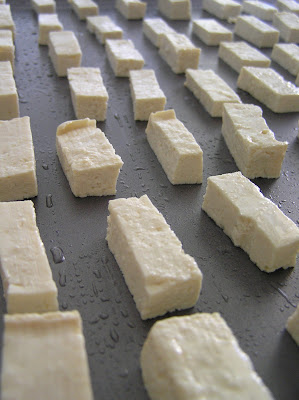 Who could resist "Mysterious Mannequin Casserole," or an "Old Attic Stuffed Tomato"? How daring to use a three step recipe to create "99 Steps French Toast"! And what nutritionist wouldn't endorse "George's 'Keep In Shape' Grapefruit" (topped, of course, with butter)?
Who could resist "Mysterious Mannequin Casserole," or an "Old Attic Stuffed Tomato"? How daring to use a three step recipe to create "99 Steps French Toast"! And what nutritionist wouldn't endorse "George's 'Keep In Shape' Grapefruit" (topped, of course, with butter)?I visited the cookbook every time I was at my friend's house, and was thrilled when she gave me a copy of my own. I enjoyed leafing through the book from time to time ("Wooden Lady Walnut Tidbits!" "Bungalow Mystery Salad"! "Hidden Window Dessert"!), but never actually tried any of the recipes. However, in honor of Halloween, I decided to create one of the dishes from the book.
The first challenge was finding a recipe which did not involve meat or meat-by-product. ("Black Key Mystery Patties," anyone?) After some sleuthing, I found several recipes that seemed edible, including broiled "Red Gate Farm Tomatoes" and "Ned's Potato Pancakes." I ultimately decided to go with "A Keene Soup," because a warm bowl of peanut butter soup sounded good after the chilly fall weather we've been having here in Denver.

I combined milk, peanut butter and cinnamon in a sauce pan, and whisked them together while heating them over medium heat (the recipe called for low, but I cheated a little - sorry Nancy!). Just as the mixture started to bubble, I removed it from heat and poured it into a serving bowl. The recipe called for the soup to be topped with whipped cream and paprika. I omitted this and, in hommage to George's healthy habits, ate the soup with sliced apples.























